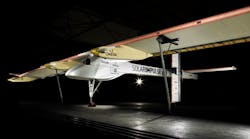PAYERNE -- The masterminds of sun-powered plane Solar Impulse formally unveiled their new aircraft Wednesday, a year ahead of their planned round-the-world flight.
Solar Impulse 2 is the successor of the original plane of the same name, which last year completed a trip across the United States without using a drop of fuel.
"These two airplanes are the most energy efficient airplanes ever designed," pilot Andre Borschberg told a 500-strong audience of officials, sponsors and diplomats at Switzerland's Payerne airbase.
"The first plane was a prototype, a flying laboratory," said the former Swiss Air Force jet pilot.
Solar Impulse 2 is a bigger, better version of its predecessor, he said, reeling off the new aircraft's statistics.
The new plane has a wingspan of 72 meters. While that is the same as an Airbus A380, at just 2,300 kilos, Solar Impulse 2 is less than 1 percent than the weight of the super jumbo jet.
That is thanks to the fact that the plane is built from carbon layers that weigh less than 25 gram per square meter -- one third of the weight of a sheet of paper, Borschberg said.
It will be powered by a massive 17,248 solar cells spread across its wings and fuselage.
The goal, Borschberg said, is to be able to fly for at least 120 hours non-stop around the globe.
After test flights in Switzerland starting from next month, the plan is to take off sometime after March 1, 2015 from a location in the Gulf, ideal for its weather conditions, and head eastwards.
"We will need at least five days and five nights to fly from China to the U.S. and from the U.S. back to Europe," said Borschberg.
While that cannot compete with traditional air travel, the point of the project is to push the boundaries of green-flavoured research, said fellow pilot Bertrand Piccard, the latest member of a dynasty of Swiss scientists-cum-adventurers.
Development of Design
"If you say you want to fly around the world in a solar airplane, everyone thinks you're crazy," said Piccard, who in 1999 was the first person to fly around the world non-stop in a hot-air balloon.
"But technology doesn't come out of the blue," he added, noting that spin-offs from such projects are crucial for sectors from energy to auto manufacturing, and bio-science to chemicals.
Borschberg said that the plane's designers had wrestled with issues such as the fact that more reliable technology tends to be heavier, but that weight means less performance.
Other issues to resolve have been how to ensure pilot safety at an altitude of 8,000 meters on a flight that will cross oceans.
"We didn't want to spend time taking swimming lessons, so we really want to make sure we have no trouble in the air," Borschberg said, laughing.
Borschberg and Piccard founded the Solar Impulse project themselves over a decade ago, after previously having struggled to get traditional aircraft manufacturers to take them seriously.
"Each time I look at this airplane, I have a memory of my childhood coming back and I am sure you have the same memory: it's the Walt Disney animation cartoon Dumbo," a tongue in cheek Piccard told the crowd.
"When Solar Impulse was born 12 years ago and we could show the enormous wings and the light weight of its structure on a computer design, all the specialists in world aviation started to laugh like stupid people can laugh at Dumbo. Today this airplane exists."
The first Solar Impulse took to the air in 2009.
The following year it notched up a 26-hour flight that proved it was able to stock up enough electricity during the day in order to keep flying at night.
Before its trans-American flight last year, the plane had already flown through Europe and crossed the Mediterranean to reach Morocco.
- Agnes Pedrero, AFP
Copyright Agence France-Presse, 2014



